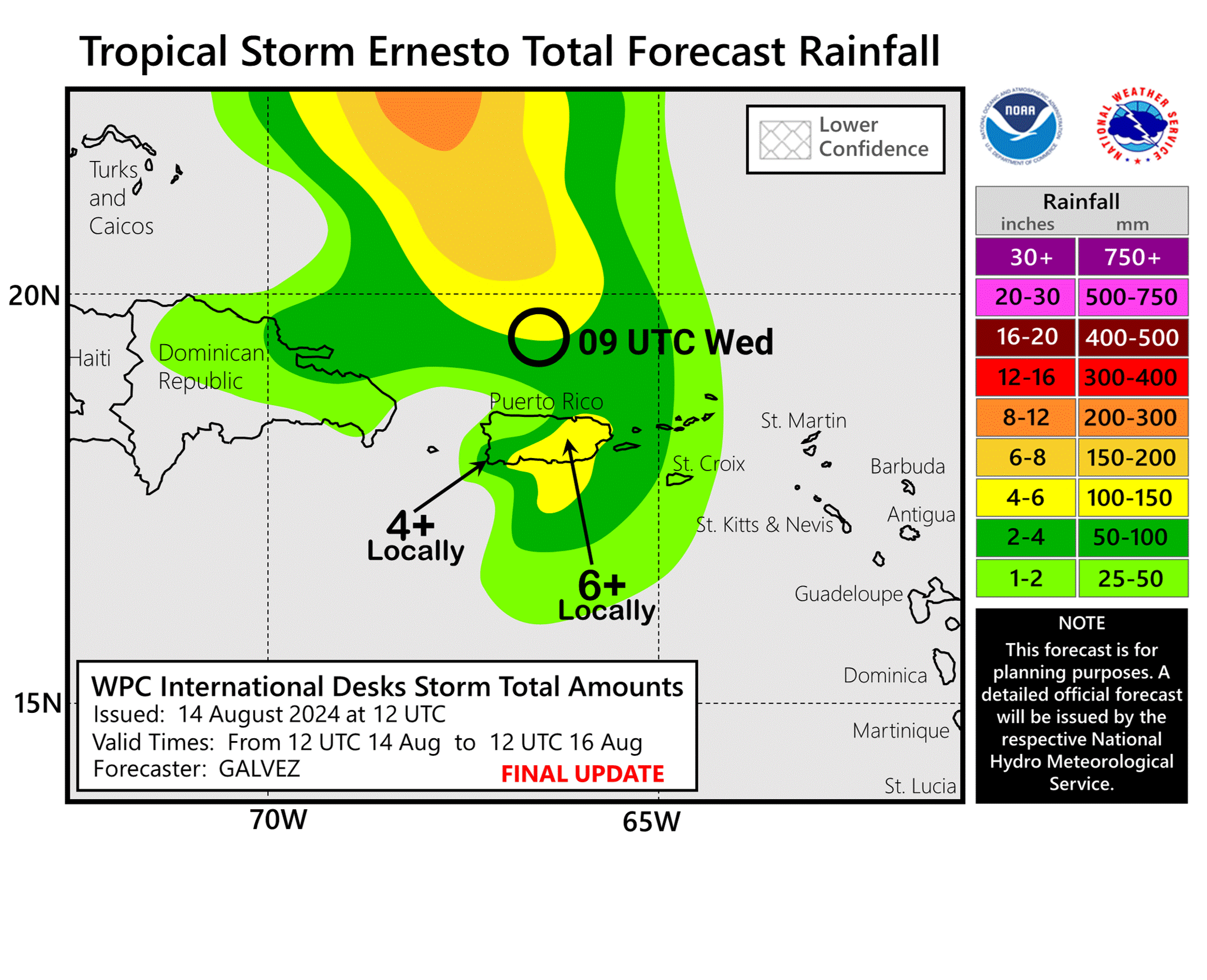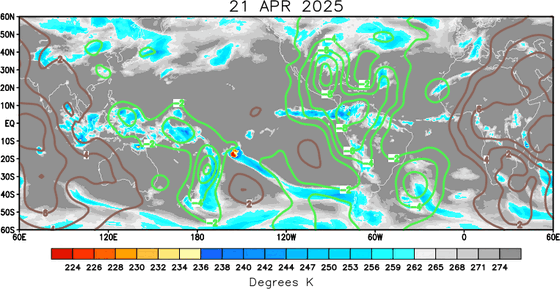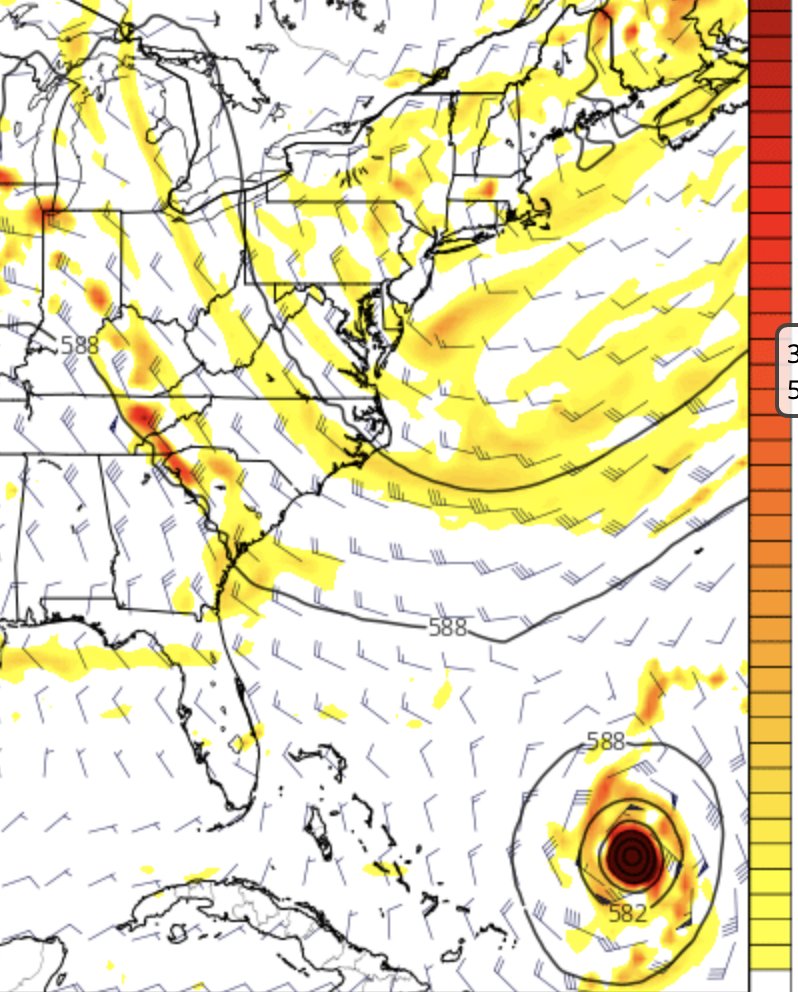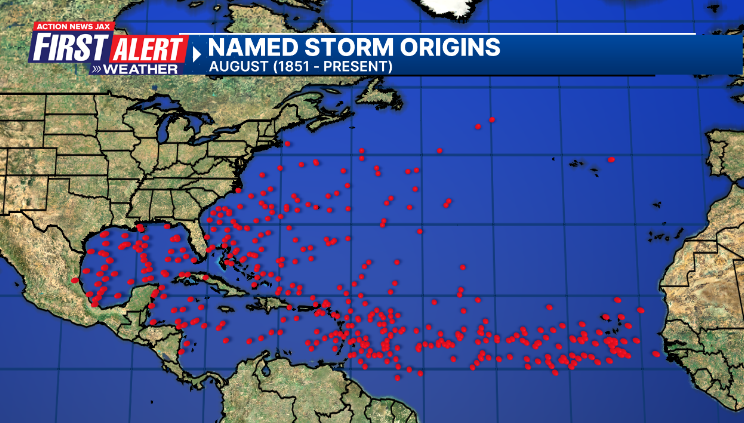Jacksonville, Fl. — The “Buresh Bottom Line”: Always be prepared!.....First Alert Hurricane Preparation Guide... City of Jacksonville Preparedness Guide... Georgia Hurricane Guide.
STAY INFORMED: Get the * FREE * First Alert Weather app
FREE NEWS UPDATES, ALERTS: Action News Jax app for Apple | For Android
WATCH “Preparing for the Storm”
WATCH “The Ins & Outs of Hurricane Season”
READ the First Alert Hurricane Center “Preparation Guide”
***** ALWAYS CHECK & RE-CHECK THE LATEST FORECAST & UPDATES! ****
Tropics threats for Jacksonville/NE Florida/SE Georgia: None though most of the upcoming week. Depending on timing, exact track & strength of what will likely be “Ernesto”, a significant rip current risk could develop along the coast by late in the week/next weekend.
The Atlantic Basin Overview:
(1) “Debby” - The 4th Atlantic named storm of the season strengthened into the 2nd hurricane of the season with the 11pm Sunday, 08/04 advisory. Debby was intensifying right up to landfall but thankfully ran out of time over the warm Gulf water with a 7am EDT landfall at Steinhatchee some 60-70 miles north/northwest of Cedar Key followed by a second landfall as a tropical storm at Bulls Bay, SC early Thu. The post-tropical low has fully merged with an upper level trough over the Northwest Atlantic.
(2) A Tropical Storm WATCH: Guadeloupe ... St. Kitts, Nevis, Montserrat, Antigua, Barbuda, and Anguilla ... Saba and St. Eustatius ... St. Martin and St. Barthelemy ... Sint Maarten ... British Virgin Islands ... U.S. Virgin Islands
The primary first ‘wave of interest’ - ‘98-L’ (’potential tropical cyclone five’) came off the coast of Africa early to mid week & will continue moving westward then veer west/northwest once approximately two-thirds west - 45 - 50 degrees W - across the Atlantic. The disturbance has a broad circulation with indications of developing outflow overhead but is otherwise still poorly organized while moving at a fast forward speed. Until a core develops with a decent concentration of convection, we may see jumps in where the system’s “center” is in addition to some erratic overall movement. Once better developed, the track should become more straight forward.
Virtually all forecast models show a hurricane eventually developing but when exactly will be huge for potential impacts on Puerto Rico & the Northern Lesser Antilles as well as the anticipated & forecast turn to the north. The GFS model is a bit more north than the European model which takes the system over the northeast edge of the island. There is a concern for pretty fast strengthening once nearing Puerto Rico.
It’s becoming obvious that a pretty stout (for late Aug.) upper level trough will dig into the Eastern U.S. & far West Atlantic through next weekend. This trough & resultant alleyway will be key in a sharp turn to the north which would keep the future tropical cyclone well east of Florida & *possibly* the entire U.S. east coast.
While forecast models have come into good agreement for the moment... the interaction with the upper trough in the longer range - once north of Florida’s latitude - is not necessarily cut & dry & will probably be at least somewhat complicated in the end.
So *for right now & it’s still early* it looks like a displacement in the Bermuda High over the Atlantic to the east should allow for the necessary alleyway to keep this tropical cyclone well east of Florida late in the week/next weekend. There will be, however, a serious rip current risk at area beaches with potentially large swells. It looks like the system will briefly stair step north over the West Atlantic before turning more northeast again. Stay up to date on the latest forecasts!
Everyone & anyone living in or traveling to the Caribbean, the Bahamas, Bermuda & along the U.S. east coast - pay attention to what is likely to become “Ernesto”.


Reminder: the shaded area below shows where tropical development is likely but is *not* a forecast cone:




The 500mb (~30,000 feet) GFS forecast for Fri., 08/16 showing the seasonally strong upper level trough that looks to “protect” Florida form Ernesto:

(3) The tropical wave that crossed the Caribbean the past week is now over the Bay of Campeche (SW Gulf of Mexico) with a noticeably increase in t’storms but will soon move inland over Mexico.
(4) Another strong tropical wave is emerging off the coast of Africa & has potential to slowly develop while moving relatively slowly westward across the Eastern & Central Atlantic. The question on this wave & its ultimate track might be the departure of the W. Atlantic upper trough & a possible expansion of the Bermuda High (which would allow for a longer westward track).
The velocity potential anomalies map below shows a lot of sinking air (brown lines) - & a lack of convection - over the Central Pacific while rising air (green lines) is over the Eastern Pacific spreading into the South Atlantic where strong convection is notable. Often the green areas (MJO pulse) will correlate with increased tropical activity. So it’s the E. Pacific that is active, & this pulse is moving eastward - signs of which we’re already seeing - helping to set off a return to a more active Atlantic.

REMEMBER WHEN A TROPICAL STORM OR HURRICANE IS APPROACHING: Taping windows is *not* recommended & will not keep glass from breaking. Instead close curtains & blinds.
Realize the forecast cone (”cone of uncertainty”) is the average forecast error over a given time - out to 5 days - & *does not* indicate the width of the storm &/or where damage might occur.
The upper oceanic heat content (UOHC) [tropical cyclone heat potential/TCHP] across the SW Atlantic, Gulf & Caribbean is unseasonably high for this time of year:






Water vapor loop (dark blue/yellow is dry mid & upper level air):


August tropical cyclone origins (early season breeding grounds are the Gulf &/or Western Caribbean:
Averages below based on climatology for the Atlantic Basin for August (1 hurricane so far, 3 tropical storms):
Wind shear (red - strong shear; green - low shear):



Saharan dust spreads west each year from Africa driven by the prevailing winds (from east to west over the Atlantic). Dry air = yellow/orange/red/pink. Widespread dust is indicative of dry air that *can* interfere with the development of tropical cyclones. However, sometimes “wanna’ be” waves will just wait until they get to the other side of - or away from - the dust plume then try to develop if other conditions are favorable (we’ve already seen this with Beryl & Debby this year). In my personal opinion, there is way too much “hoopla” about the presence of Saharan dust & how it relates to tropical cyclones. In any case, the peak of Saharan dust typically is in June & July.

2024 names..... “Ernesto” is the next name on the Atlantic list (names are picked at random by the World Meteorological Organization... repeat every 6 years). Historic storms are retired [Florence & Michael in ’18 (the last time this year’s list was used)... Dorian in ’19 & Laura, Eta & Iota in ‘20, Ida in ‘21 & Fiona & Ian in ‘22]). In fact, this year’s list of names is rather infamous because of the ‘04 season when Charley, Frances, Jeanne & Ivan - all retired names - hit Florida within a matter of about 6 weeks. The WMO decided - beginning in 2021 - that the Greek alphabet will be no longer used & instead there will be a supplemental list of names if the first list is exhausted (has only happened three times - 2005, 2020 & 2021). The naming of tropical cyclones began on a consistent basis in 1953. More on the history of naming tropical cyclones * here *.





East Atlantic:





Mid & upper level wind shear (enemy of tropical cyclones) analysis (CIMMS). The red lines indicate strong shear:
Water vapor imagery (dark blue indicates dry air):

Deep oceanic heat content over the Gulf, Caribbean & deep tropical Atlantic. The colors will brighten greatly as the water warms to greater depths deeper into the season:

Sea surface temp. anomalies:


SE U.S. surface map:

Surface analysis centered on the tropical Atlantic:

Surface analysis of the Gulf:

Caribbean:

Atlantic Basin wave period forecast for 24, 48, 72 & 96 hours respectively:





East & Central Pacific:





West Pacific:

Global tropical activity:

“Maria” is turning northwest while weakening into Northern Japan:



Cox Media Group

:quality(70)/cloudfront-us-east-1.images.arcpublishing.com/cmg/JIFG55NSN5HKZK6LKEZ4C7UU5I.jpg)




:quality(70)/cloudfront-us-east-1.images.arcpublishing.com/cmg/SMNDFCD6BBDXNAYEI7VSPW2P44.jpeg)
:quality(70)/cloudfront-us-east-1.images.arcpublishing.com/cmg/SKX4RKW645ERTATCLA4V2FVRKQ.png)
:quality(70)/cloudfront-us-east-1.images.arcpublishing.com/cmg/4TQDXERT5VGORNZ4NQWXNO5H64.png)
:quality(70)/cloudfront-us-east-1.images.arcpublishing.com/cmg/VFGNOWDMQRFUNDZYHRTIPEQYYQ.jpg)
:quality(70)/cloudfront-us-east-1.images.arcpublishing.com/cmg/V7JDMMD6JJEEHIL6C7OSLV3ABU.png)
:quality(70)/cloudfront-us-east-1.images.arcpublishing.com/cmg/JZ6PJAXWC5BPK2FLASCIV3O4DY.jpg)
:quality(70)/cloudfront-us-east-1.images.arcpublishing.com/cmg/ZEAPXVQ23M3VT7NIAVVQRQHWU4.jpg)
:quality(70)/cloudfront-us-east-1.images.arcpublishing.com/cmg/K4PWV6XLSLW2RNFMYXQHY7Q6DM.jpg)
:quality(70)/cloudfront-us-east-1.images.arcpublishing.com/cmg/H2HJUACUXIC5LDD327MDALHZ4Q.jpg)
